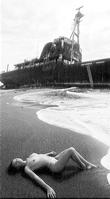Howard Moo Young, Contributor

'OLD WRECK, BEAUTIFUL BODY' by Brian Rosen
Brian found the perfect location along the Palisadoes Road on the ocean side to capture this beautiful photograph of a nude in complete contrast to the rotting ship in the background, connected by the white foam of the waves along the black sand. Need I say more?
This is a favourite word of my friend and fellow photographer, Robert Paisley, whom I have a lot of respect for when it comes to photography. As a judge in our club's monthly slide clinics, he always used it appropriately to describe a particular photograph when two or more objects were placed in certain positions to create an impact.
The dictionary describes it as (1) the action of putting close together; a placing side by side: The juxtaposition of red curtains against yellow walls was startling. (2) a position close together or side by side: The twins stood in juxtaposition for their picture.
In life, situations can occur before your very eyes that were never planned, that can create unusual images. At other times, you have total control over the precise positioning of objects in front of your camera to
create a beautiful juxtaposition.
By placing one image or subject against another, the photographer implies a relationship between the two. In most situations, this relationship will be natural, real and without hidden meanings; however, you also have the opportunity to create relationships from your own imagination by various means. Consider, for instance, a still-life composition using an egg. If you construct the image with an egg and spoon, then there is no possible confusion as to what is about to happen to the egg. If, on the other hand, you place a hammer next to the egg, the situation is very different. As the two appear next to each other, the relationship is clearly intentional, the only natural construction being that the hammer is for breaking the egg. What is unresolved is the reason for this.
Effective with symbols
This is juxtaposition on an extremely basic level, involving the positioning of one object next to another and relying on the functions or associations of each to spell out an idea. Not surprisingly, juxtaposition is particularly effective with symbols; there are several techniques for combining them, ranging from straightforward placement to the more complex methods of double exposure and montage. Although effort is needed to solve the technical problems in such photographs, it is the idea that should be paramount. It is important to resist getting caught up in technical detail.
The relationship may be clear-cut, or it may be deliberately enigmatic. It may be even be a purely graphic relationship -
making comparisons between shapes, for example. Juxtapositions, too, can be complementary (one subject reinforcing another either graphically, or in its associations), or contrasting (where a relationship is forced on to two dissimilar subjects).
Howard Moo Young is an advertising/graphic design/photography consultant with over 40 years experience. Email:
howardmooyoung@getcaughtmedia.com

